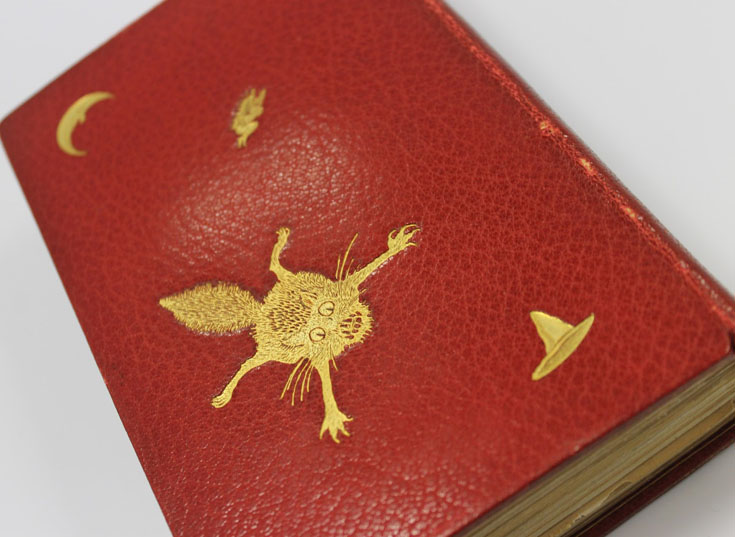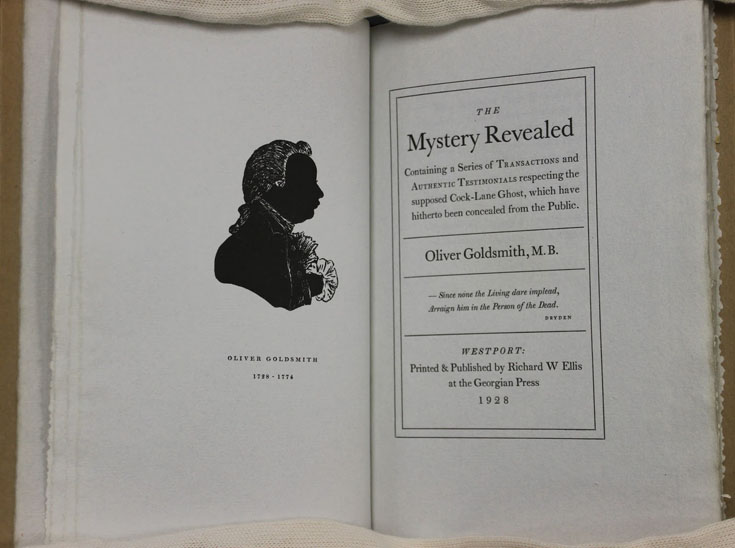Witches, Demons and Ghosts in Special Collections
October 2, 2016
Description by Matthew Chernick, master's student in comparative humanities and Archives & Special Collections assistant.
 Among the items held in the Brandeis University Archives and Special Collections are numerous rare volumes on a subject quite fitting for autumn in New England: the supernatural. Among the topics covered in these books are witchcraft, demons and ghosts. The field that studies such phenomena is referred to as demonology. The volumes range in date from the 16th to the 20th century and are written by figures from literature, religion and the history of medicine. Interestingly enough, many of these books are skeptical, rational responses to the rising paranoia caused by Reformation era witch trials and anti-Enlightenment or Romantic era obsessions with the supernatural.
Among the items held in the Brandeis University Archives and Special Collections are numerous rare volumes on a subject quite fitting for autumn in New England: the supernatural. Among the topics covered in these books are witchcraft, demons and ghosts. The field that studies such phenomena is referred to as demonology. The volumes range in date from the 16th to the 20th century and are written by figures from literature, religion and the history of medicine. Interestingly enough, many of these books are skeptical, rational responses to the rising paranoia caused by Reformation era witch trials and anti-Enlightenment or Romantic era obsessions with the supernatural.
De Praestigiis Daemonum, & Incantationibus ac Veneficiis Libri Sex: Postrema editione sexta aucti & recogniti: accessit liber apologeticus, et pseudomonarchia daemonum: Cum rerum ac verborum copioso indice
Johann Weyer (1583, originally published in 1563)
 The title of this book, written by notable 16th-century Dutch-German demonologist Johann Weyer, translates to On the Illusions of Demons. Written in Latin, Weyer’s book is considered a foundational study in the field of the supernatural, and also to be quite ahead of its time in method and scope. De Praestigiis covers magic spells and potions but its most famous section is Pseudomonarchia Daemonum [The False Kingdom of the Demons], a catalogue of major demons and their supposed rankings in Hell.[1] Weyer wished to address the rampant witch hysteria of his day and he believed that “evidence” of the supernatural could be explained by logical, rational means. His famous index of demons is generally considered an attempt to debunk theories of vast hierarchies of Hell. While Weyer based his research and writing in contemporary theology, he was ahead of his time in proffering ideas that today might be categorized as literary studies, cultural and folk history, psychology, sociology, and medicine. Due to his focus on mental origins of witchcraft and demonic possession, Weyer is sometimes considered a proto-pioneer in psychiatry. The Brandeis University Library holds English translations of this text.
The title of this book, written by notable 16th-century Dutch-German demonologist Johann Weyer, translates to On the Illusions of Demons. Written in Latin, Weyer’s book is considered a foundational study in the field of the supernatural, and also to be quite ahead of its time in method and scope. De Praestigiis covers magic spells and potions but its most famous section is Pseudomonarchia Daemonum [The False Kingdom of the Demons], a catalogue of major demons and their supposed rankings in Hell.[1] Weyer wished to address the rampant witch hysteria of his day and he believed that “evidence” of the supernatural could be explained by logical, rational means. His famous index of demons is generally considered an attempt to debunk theories of vast hierarchies of Hell. While Weyer based his research and writing in contemporary theology, he was ahead of his time in proffering ideas that today might be categorized as literary studies, cultural and folk history, psychology, sociology, and medicine. Due to his focus on mental origins of witchcraft and demonic possession, Weyer is sometimes considered a proto-pioneer in psychiatry. The Brandeis University Library holds English translations of this text.
Letters on Demonology and Witchcraft: Addressed to J. G. Lockhart, Esq.
Sir Walter Scott (1830)
 Sir Walter Scott, famed author of Romantic historical novels, wrote Letters two years before he died, while recovering from the first of several strokes and looking for a change from his typical subject matter. The book is composed of ten letters to his son in law J.G. Lockhart (who suggested the topic) and presents a rational view of demonology and the supernatural. Scott presents these phenomena and the witch trials that followed as resulting from medical causes (much like Weyer) or stemming from early Christians’ misunderstanding of foreign religions (especially Islam). He also noted that as witch trials grew in popularity, the charges were often conflated with political crimes against the state. The book itself is bound in a beautiful red cover embossed with images of typical witch’s items: pointed hats, broomsticks, toads, and cats. Particularly stunning are the ten full-color illustrations, drawn by George Cruikshank, depicting the creatures and figures discussed in the text.[2] Cruikshank was also a noted illustrator for Victorian novelist Charles Dickens, who is in turn connected to the next book discussed below.
Sir Walter Scott, famed author of Romantic historical novels, wrote Letters two years before he died, while recovering from the first of several strokes and looking for a change from his typical subject matter. The book is composed of ten letters to his son in law J.G. Lockhart (who suggested the topic) and presents a rational view of demonology and the supernatural. Scott presents these phenomena and the witch trials that followed as resulting from medical causes (much like Weyer) or stemming from early Christians’ misunderstanding of foreign religions (especially Islam). He also noted that as witch trials grew in popularity, the charges were often conflated with political crimes against the state. The book itself is bound in a beautiful red cover embossed with images of typical witch’s items: pointed hats, broomsticks, toads, and cats. Particularly stunning are the ten full-color illustrations, drawn by George Cruikshank, depicting the creatures and figures discussed in the text.[2] Cruikshank was also a noted illustrator for Victorian novelist Charles Dickens, who is in turn connected to the next book discussed below.
The Mystery Revealed: Containing a Series of Transactions and Authentic Testimonials Respecting the Supposed Cock-Lane Ghost, Which Have Hitherto Been Concealed from the Public
Goldsmith, Oliver (1928 reprint of the 1762 ed. printed for W. Bristow, London.)
 This artifact is a 1928 reprinting of a 1762 pamphlet presumably written and produced by Irish playwright and author Oliver Goldsmith. The subject of the pamphlet is the “Cock Lane Ghost,” the name given to a strange occurrence that achieved widespread fascination in late 18th-century England. William Kent, a usurer from the countryside, moved to London with the sister of his dead wife, with whom he was in a relationship. His lover later died and many thought foul play was involved. Kent and his landlord, Richard Parsons, entered into litigation about money. Some years later, at the building that served as their lodgings in Cock Lane, Elizabeth, the daughter of Kent’s landlord, began to suffer fits accompanied by strange sounds in the building, most notably “knocking” or “scratching” sounds. It was
This artifact is a 1928 reprinting of a 1762 pamphlet presumably written and produced by Irish playwright and author Oliver Goldsmith. The subject of the pamphlet is the “Cock Lane Ghost,” the name given to a strange occurrence that achieved widespread fascination in late 18th-century England. William Kent, a usurer from the countryside, moved to London with the sister of his dead wife, with whom he was in a relationship. His lover later died and many thought foul play was involved. Kent and his landlord, Richard Parsons, entered into litigation about money. Some years later, at the building that served as their lodgings in Cock Lane, Elizabeth, the daughter of Kent’s landlord, began to suffer fits accompanied by strange sounds in the building, most notably “knocking” or “scratching” sounds. It was  claimed the ghost of Kent’s first wife was haunting the children. This became a something of a national obsession, and was investigated through two séances organized by a committee of noted figures of the day, among them the writer Samuel Johnson. Johnson and others believed it was a hoax to cover up foul play and impropriety, and Parson and several of his supporters were eventually tried and found guilty of conspiracy against Kent.[3]
claimed the ghost of Kent’s first wife was haunting the children. This became a something of a national obsession, and was investigated through two séances organized by a committee of noted figures of the day, among them the writer Samuel Johnson. Johnson and others believed it was a hoax to cover up foul play and impropriety, and Parson and several of his supporters were eventually tried and found guilty of conspiracy against Kent.[3]
 The pamphlet takes the view that the ghost is real, and was intended to support Kent’s innocence in the entire event. The Cock-Lane ghost remained a cultural touchstone of English life for the next century, giving rise to the popular phrase “One Knock for Yes, Two Knocks for No” used in the popular images of séances. Its impact on literature was especially notable. Charles Dickens, writing in his great novel A Tale of Two Cities almost one hundred years later, uses references to this ghost as a way of developing a sense of the time for the late 19th century in the opening chapter “The Period.”[4]
The pamphlet takes the view that the ghost is real, and was intended to support Kent’s innocence in the entire event. The Cock-Lane ghost remained a cultural touchstone of English life for the next century, giving rise to the popular phrase “One Knock for Yes, Two Knocks for No” used in the popular images of séances. Its impact on literature was especially notable. Charles Dickens, writing in his great novel A Tale of Two Cities almost one hundred years later, uses references to this ghost as a way of developing a sense of the time for the late 19th century in the opening chapter “The Period.”[4]
More Information
These are just a few of the fascinating items on occult that are held by the Archives and Special Collections at Brandeis University. And of course, all these items are available for public and scholarly perusal!
For more on Brandeis’ supernatural special collections, see this BrandeisNOW article on “Witches in the Archives.”
Notes
- Wikipedia. De praestigiis daemonum.
- Edinburgh University Library. The Walter Scott Digital Archive.
- Wikipedia. Cock Lane Ghost.
- Dickens, Charles. A Tale of Two Cities, 1859.